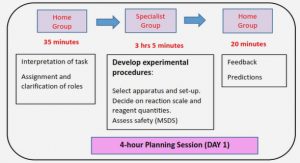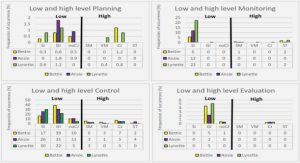Get Complete Project Material File(s) Now! »
Actual evaporation (ET)
It is the quantity of water that is actually transferred as water vapour to the atmosphere from an evaporating surface (Wiesner, 1970). This surface can vary: ocean, rivers, lakes, soil, vegetation, etc. Actual evaporation can be decomposed into the evaporation of bare soil, the vegetation transpiration and the evaporation for rain interception.
There are five basic climatological parameters in its computation. The first two are the available radiative energy and the air temperature, which provide the energy needed to vaporise the molecules. The third one is the air humidity, which is key in the vapour pressure gradient between the surface and the atmosphere. This gradient is the driving force that removes water vapour from the surface. It has to be noted that the vapour pressure deficit is used instead of the gradient in some methodologies. The fourth one is the wind speed, which is in charge of generating the turbulence needed to transfer the saturated air to the atmosphere, replacing it by a drier one. This action allows the evaporation process to continue. Otherwise, the air above the evaporating surface would end up saturating, and the evaporation would eventually cease. Finally, there is the water availability to be evaporated. In addition to these parameters, other surface variables are also important, like the saturated specific humidity (to compute the above mentioned vapour pressure gradient), or the type of vegetation (which defines the roughness and albedo that have also an impact on evaporation).
Potential evaporation (ETP)
The literature provides different definitions for the concept of “potential evapotranspiration”. It was coined in 1948 by Thornthwaite, when he referred to it not as the actual transfer of water to the atmosphere but the one that would be “possible under ideal conditions of soil moisture and vegetation”. To do so, he put as an example that the desert’s vegetation is sparse due to the fact that water availability is deficient. However, if there was more water, vegetation would take profit of it, use it and increase its presence.
He highlighted some important facts, like that it has to be determined experimentally since it can not be measured directly, and that it depends only on climate conditions, because the availability of water is assumed to be complete. He also remarked that just as actual evaporation, potential evaporation is an important climatic parameter. Among other reasons, it allows to define the moisture availability factor (β).
The concept has been redefined and modified, and various definitions can be found for it. For instance, Granger (1989) identifies five different types of potential evaporation. All of them share in common that it is the evaporation rate that would occur if the surface was saturated, but vary depending on the fact that i) the energy supply to the surface, ii) the atmospheric parameters, and / or iii) the surface temperature are held constant or not. Out of the five definitions, three of them are selected arguing that either the definition provides an easy methodology to estimate potential evaporation, or appropriate limits for evaporation from a non-stressed surface.
The above paragraph shows that there is not a unique stated ETP definition. In addition, since the definitions differ, the estimations are not likely to be equal. It should to be noted too that, for the same definition, implementations may adopt different assumptions.
Therefore, all of these reasons evidence the complexity of the analysis of this variable. In the study carried out for this thesis, the ETP is considered to be the amount of evaporation that would occur if enough water was available in the surface. No land surface process is considered to limit it. In other words, it is the atmospheric demand for water.
Therefore, recalling the five key climatological parameters in the computation of the actual evaporation, the availability of water to evaporate is not considered in the estimation of potential evaporation. The other four parameters remain important ETP parameters.
Reference evapotranspiration (ETo)
Allen et al. (1998) define ETo as the evapotranspiration rate from a reference surface. The reference surface is a “hypothetical grass reference crop with an assumed crop height of 0.12 m, a fixed surface resistance of 70 sm-1 and an albedo of 0.23”. It describes it as an extensive surface of green well-watered grass of uniform height, actively growing and which completely covers the ground. Since the surface resistance is known, the only factors ETo depends on are climatological parameters. The four basic ETP parameters (available radiative energy, air temperature, humidity gradient / deficit and the wind speed) remain important ETo parameters. There is, however, an important difference between these two concepts, which is the land surface characterization. As detailed in the definition of the reference surface, there are parameters like the height, type and homogeneity of crop and albedo that are fixed.
The Food and Agriculture Organization (FAO) reference evapotranspiration equation provides a methodology that is recommended as the standard for estimating ETo. Its aim is to study the atmosphere’s evaporative demand independently of the type, development and management of the surface’s crop. Further on, crop evapotranspiration may be computed by multiplying ETo by the crop coefficients. These are computed taking into account the characteristics that differ the crop from the reference surface described above. There are two types of coefficients, single and dual (distinguishing crop transpiration and soil evaporation).
Pan evaporation (ETPpan)
ETPpan is the amount of water that evaporates from a pan. Allen et al. (1998) explain that pan evaporation shows the integrated effect of radiation, temperature, humidity and wind on evaporation from an open-water surface. Its measure can be converted to reference evaporation by applying empirical coefficients, called pan coefficients. However, it has to be noted that precautions must be taken. For example, the energy exchange between the borders and bottom of the pan must be considered regarding the energy balance. In addition, heat storage might be significant, causing evaporation during the night, opposite to most crops which transpire during daytime. Solar radiation reflection from water in the shallow pan and grass will differ, as well as the state of the air, regarding turbulence, temperature and humidity, above both surfaces. The pan must also be surrounded by a fence to prevent animals drinking the water. For Brutsaert and Parlange (1998), ETPpan can be considered as a good indicator of actual evaporation, but only when there is enough supply of soil moisture.
There are different types of pans. For example, if Class-A pans are to be compared with Colorado ones, it will be found that they differ in their shape (circular vs. squared), depth (25cm vs. 46cm), and material (galvanized iron vs. thick iron), among others. The setting also varies. While, A-pans are to be mounted on a wooden open frame, the Colorado ones are located in the soil. Due to these differences, the pan coefficients are pan specific. Their computation is approached in different ways: i) comparing pan evaporation with open-surface water estimates or by ii) empirically-derived relationships (Kohler et al., 1955) ; (Allen et al., 1998).
Pan evaporation is an important parameter to take into account. Among other reasons, this method provides a large temporal record of measured data corresponding to evaporation from an open water surface. In this thesis, we will not work with this concept. However, we wanted to draw the reader’s attention to the fact that there are further evaporation concepts, apart from the actual, potential and reference ones.
Estimation of actual and potential evaporation
The aim of this section is to provide the reader with a general background of the main methodologies that exist to measure actual evaporation. These will be divided into fundamental equations, observation and estimation methods, as well as remote sensing and LSM methods.
ET from fundamental equations
The computation of evaporation can be approached through the use of two fundamental equations: the energy and water balances. In fact, throughout this section, we will deal with methods which are based on them.
ET from assimilation methods
These methods serve to complement remote sensing ones in the way that ET derived from remote sensed data will not be continuous through time. This is because remote sensing offers a complete spatial coverage, but not a temporal one. In addition, clouds limit data retrieval and certain parameters, like albedo or Ts may not be accurately measured. The Land Data Assimilation Systems (LDAS) is a methodology which is based on forcing land surface models with observations, like gauge and radar measurements of precipitation and satellite data. In addition, it uses outputs from numerical prediction models. It has to be noted that these LSMs must be uncoupled from atmospheric models in order to avoid errors caused by numerical weather prediction forcing biases. We can identify NLDAS, that refers to the North American LDAS, and GLDAS, referred to global ones (Rodell et al., 2004). This methodology is being applied in different areas, like investigating the energy and water cycles, numerical weather prediction, or in the evaluation of observations performed using remote sensing techniques or ground-based methodologies. Moreover, data assimilation techniques can use the proper LDAS observations (soil moisture, snow, or fluxes like runoff or evaporation) to validate and constrain the LDAS predictions. An example of the LDAS methodology linked to the estimation of evaporation is detailed in Peters-Lidard et al. (2011).
We will now discuss methodologies to estimate potential evaporation. Various methods have been developed for this purpose. In this study, we have classified them based on the approach to estimate it and their type. For the first one, we have distinguished physically and empirical-based methods. For the second one, we have taken into account that the estimation of ETP may be performed by means of two different approaches. In one case, the estimation is mainly dominated by the turbulent diffusion equation, and, in the other one, it is done based on the surface-energy balance equation (Monteith, 1981). Although both of the equations are treated when developing the estimation methods, each methodology emphasizes on one of them. Therefore, we will talk about the diffusive and surface-energy balance approaches, and we will distinguish methods that are based on one or the other.
Empirical methods for ETP
Opposite to the physical methods, empirical methods have been developed to provide further simplified equations to estimate ETP. The main reasons are equivalent to those given for the development of FAO’s methodology: the time step estimation and the lack of data availability. For instance, there is a great amount of literature concerning methods based on some or only one of the parameters ETP depends on. Some examples are the temperature, radiation and mass-transfer based methods (Xu and Singh, 2002). Another important characteristic that needs to be highlighted is that these type of methods contain site-specific parameters that have to be calibrated for each region.
In this study, we have computed the atmospheric demand by means of a radiation and mass-transfer based method which correspond to the energy balance and diffusive approaches, respectively. We have also estimated ETo using an empirical method, based on temperature to extend the sensitivity study to the reference evapotranspiration. These methods will be described below.
Table of contents :
1 Introduction
1.1 General background
1.2 Motivation
1.3 General methodology
1.4 Document structure
2 Presentation of the study framework
2.1 The hydrological cycle
2.2 The climate change
2.3 The Evaporation Concept
2.4 Soil Moisture
2.5 Land Surface Models
2.6 Remote Sensing: SMOS
3 Methodology
3.1 Introduction
3.2 Simulations performed with ORCHIDEE
3.3 Potential Evaporation’s sensitivity to climate change
3.4 Brightness Temperatures comparison between SMOS’s observations and a radiative transfer model output
4 Potential evaporation sensitivity to climate change
4.1 Introduction
4.2 Potential evaporation estimation through an unstressed surface-energy balance and its sensitivity to climate change
4.3 Further analysis performed
4.4 Partial conclusion
5 Comparison of measured and modelled brightness temperatures
5.1 Introduction
5.2 Soil moisture comparison
5.3 Brightness temperature comparison
5.4 Partial conclusion and discussion
6 Synthesis and perspectives
6.1 Synthesis
6.2 Perspectives
7 Appendices
7.1 List of acronyms
7.2 List of constants and variables
8 Bibliography





